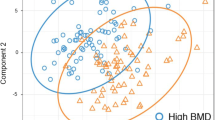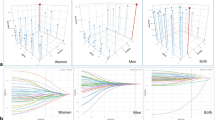Abstract
Purpose of Review
To systematically review recent studies investigating the association between metabolites and bone mineral density (BMD) in humans.
Methods
Using predefined keywords, we searched literature published from Jan 1, 2019 to Feb 20, 2022 in PubMed, Web of Science, Embase, and Scopus. Studies that met the predefined exclusion criteria were excluded. Among the included studies, we identified metabolites that were reported to be associated with BMD by at least three independent studies.
Recent Findings
A total of 170 studies were retrieved from the databases. After excluding studies that did not meet our predefined inclusion criteria, 16 articles were used in this review. More than 400 unique metabolites in blood were shown to be significantly associated with BMD. Of these, three metabolites were reported by ≥ 3 studies, namely valine, leucine and glycine. Glycine was consistently shown to be inversely associated with BMD, while valine was consistently observed to be positively associated with BMD. Inconsistent associations with BMD was observed for leucine.
Summary
With advances in metabolomics technology, an increasing number of metabolites associated with BMD have been identified. Two of these metabolites, namely valine and glycine, were consistently associated with BMD, highlighting their potential for clinical application in osteoporosis. International collaboration with a larger population to conduct clinical studies on these metabolites is warranted. On the other hand, given that metabolomics could be affected by genetics and environmental factors, whether the inconsistent association of the metabolites with BMD is due to the interaction between metabolites and genes and/or lifestyle warrants further study.

Similar content being viewed by others
Data Availability
Data supporting this systematic review are available in the Supplementary Information and reference section.
References
Papers of particular interest, published recently, have been highlighted as: • Of importance •• Of major importance
Salari N, et al. Global prevalence of osteoporosis among the world older adults: a comprehensive systematic review and meta-analysis. J Orthop Surg Res. 2021;16(1):669. https://doi.org/10.1186/s13018-021-02821-8.
Dobbs MB, Buckwalter J, and Saltzman C. Osteoporosis: the increasing role of the orthopaedist. Iowa Orthop J, 1999;19:43–52, https://www.ncbi.nlm.nih.gov/pmc/articles/PMC1888612/. Accessed 8 Mar 2023.
Ji M-X, Yu Q. Primary osteoporosis in postmenopausal women. Chronic Dis Transl Med. 2015;1(1):9–13. https://doi.org/10.1016/j.cdtm.2015.02.006.
Global Burden of Disease Collaborative Network, Global Burden of Disease Study 2019 (GBD 2019) Results. Seattle, United States: Institute for Health Metrics and Evaluation (IHME), 2020. Available from https://vizhub.healthdata.org/gbd-results/. Accessed 13 Mar 2023.
RashkiKemmak A, et al. Economic burden of osteoporosis in the world: A systematic review. Med J Islam Repub Iran. 2020;34:154–154. https://doi.org/10.34171/mjiri.34.154.
Williamson S, et al. Costs of fragility hip fractures globally: a systematic review and meta-regression analysis. Osteoporos Int. 2017;28(10):2791–800. https://doi.org/10.1007/s00198-017-4153-6.
Cheung CL, et al. An updated hip fracture projection in Asia: The Asian Federation of Osteoporosis Societies study. Osteoporos Sarcopenia. 2018;4(1):16–21. https://doi.org/10.1016/j.afos.2018.03.003.
Mei Z, et al. Association between the metabolome and bone mineral density in a Chinese population. EBioMedicine. 2020;62:103111. https://doi.org/10.1016/j.ebiom.2020.103111.
Bernabei R et al. Screening, diagnosis and treatment of osteoporosis: a brief review. Clin Cases Miner Bone Metab, 2014;11(3):201–207, https://www.ncbi.nlm.nih.gov/pmc/articles/PMC4269144/. Accessed 13 Mar 2023.
Johnell O, et al. Predictive value of BMD for hip and other fractures. J Bone Miner Res. 2005;20(7):1185–94. https://doi.org/10.1359/JBMR.050304.
Kanis JA, et al. Development and use of FRAX in osteoporosis. Osteoporos Int. 2010;21(Suppl 2):S407–13. https://doi.org/10.1007/s00198-010-1253-y.
Hippisley-Cox J, Coupland C. Derivation and validation of updated QFracture algorithm to predict risk of osteoporotic fracture in primary care in the United Kingdom: prospective open cohort study. Bmj. 2012;344:e3427. https://doi.org/10.1136/bmj.e3427.
Leslie WD, et al. Direct comparison of eight national FRAX® tools for fracture prediction and treatment qualification in Canadian women. Arch Osteoporos. 2013;8(1):145. https://doi.org/10.1007/s11657-013-0145-0.
Miggiels P, et al. Novel technologies for metabolomics: More for less. TrAC Trends Anal Chem. 2019;120:115323. https://doi.org/10.1016/j.trac.2018.11.021.
Odom JD, Sutton VR. Metabolomics in Clinical Practice: Improving Diagnosis and Informing Management. Clin Chem. 2021;67(12):1606–17. https://doi.org/10.1093/clinchem/hvab184.
Miyamoto K et al. A Metabolomic Profile Predictive of New Osteoporosis or Sarcopenia Development. Metabolites, 2021;11(5). https://doi.org/10.3390/metabo11050278.
Miyamoto T, et al. Metabolomics-based profiles predictive of low bone mass in menopausal women. Bone Reports. 2018;9:11–8. https://doi.org/10.1016/j.bonr.2018.06.004.
Aleidi SM, et al. A Distinctive Human Metabolomics Alteration Associated with Osteopenic and Osteoporotic Patients. Metabolites. 2021;11(9):628. https://doi.org/10.3390/metabo11090628.
Zhang X, et al. Metabolomics Insights into Osteoporosis Through Association With Bone Mineral Density. J Bone Miner Res. 2021;36(4):729–38. https://doi.org/10.1002/jbmr.4240.
Liberati A, et al. The PRISMA statement for reporting systematic reviews and meta-analyses of studies that evaluate healthcare interventions: explanation and elaboration. BMJ. 2009;339:b2700. https://doi.org/10.1136/bmj.b2700.
Gong R, et al. Identification and Functional Characterization of Metabolites for Bone Mass in Peri- and Postmenopausal Chinese Women. J Clin Endocrinol Metab. 2021;106(8):e3159–77. https://doi.org/10.1210/clinem/dgab146.
•• Li P, et al. Metabolic Alterations in Older Women With Low Bone Mineral Density Supplemented With Lactobacillus reuteri. JBMR Plus. 2021;5(4):e10478. https://doi.org/10.1002/jbm4.10478. (Study demonstrated the theraputic potential of probiotics supplement on osteoporosis in older women by altering metabolome.)
• Palacios-González B et al. A Multi-Omic Analysis for Low Bone Mineral Density in Postmenopausal Women Suggests a RELATIONSHIP between Diet, Metabolites, and Microbiota. Microorganisms, 2020;8(11). https://doi.org/10.3390/microorganisms8111630. (Multiomic study revealed the correlation between metabolome, diet and microbiota in Mexican population, leucine and valine were shown to be associated to BMD.)
Pontes TA, et al. Osteopenia-osteoporosis discrimination in postmenopausal women by 1H NMR-based metabonomics. PLoS One. 2019;14(5):e0217348. https://doi.org/10.1371/journal.pone.0217348.
Bellissimo MP, et al. Plasma high-resolution metabolomics identifies linoleic acid and linked metabolic pathways associated with bone mineral density. Clin Nutr. 2021;40(2):467–75. https://doi.org/10.1016/j.clnu.2020.05.041.
Chau Y-P, et al. Serum Metabolome of Coffee Consumption and its Association With Bone Mineral Density: The Hong Kong Osteoporosis Study. J Clin Endocrinol Metab. 2019;105(3):e619–27. https://doi.org/10.1210/clinem/dgz210.
Deng D et al. An Integrated Metabolomic Study of Osteoporosis: Discovery and Quantification of Hyocholic Acids as Candidate Markers. Front Pharmacol, 2021;12. https://doi.org/10.3389/fphar.2021.725341.
Hartley A, et al. Metabolomics analysis in adults with high bone mass identifies a relationship between bone resorption and circulating citrate which replicates in the general population. Clin Endocrinol (Oxf). 2020;92(1):29–37. https://doi.org/10.1111/cen.14119.
He J, et al. Gut microbiota and metabolite alterations associated with reduced bone mineral density or bone metabolic indexes in postmenopausal osteoporosis. Aging. 2020;12(9):8583–604. https://doi.org/10.18632/aging.103168.
• Ling CW, et al. The Association of Gut Microbiota With Osteoporosis Is Mediated by Amino Acid Metabolism: Multiomics in a Large Cohort. J Clin Endocrinol Metab. 2021;106(10):e3852–64. https://doi.org/10.1210/clinem/dgab492. (Multiomic study of osteoporosis focused on amino acids metabolism and microbiota in a large Chinese cohort.)
Mangano KM, et al. Diet-derived fruit and vegetable metabolites show sex-specific inverse relationships to osteoporosis status. Bone. 2021;144:115780. https://doi.org/10.1016/j.bone.2020.115780.
Palacios-Gonzalez B et al. Serum Metabolite Profile Associated with Sex-Dependent Visceral Adiposity Index and Low Bone Mineral Density in a Mexican Population. Metabolites, 2021;11(9). https://doi.org/10.3390/metabo11090604.
Wang J, et al. Discovery of potential biomarkers for osteoporosis using LC-MS/MS metabolomic methods. Osteoporos Int. 2019;30(7):1491–9. https://doi.org/10.1007/s00198-019-04892-0.
Su Y, et al. Circulating amino acids are associated with bone mineral density decline and ten-year major osteoporotic fracture risk in older community-dwelling adults. Bone. 2019;129:115082–115082. https://doi.org/10.1016/j.bone.2019.115082.
Cui Z, et al. Relationship Between Serum Amino Acid Levels and Bone Mineral Density: A Mendelian Randomization Study. Front Endocrinol. 2021;12:763538–763538. https://doi.org/10.3389/fendo.2021.763538.
•• Sartori T, et al. Branched chain amino acids improve mesenchymal stem cell proliferation, reducing nuclear factor kappa B expression and modulating some inflammatory properties. Nutrition. 2020;78:110935. https://doi.org/10.1016/j.nut.2020.110935. (Study demonstrated the effect of BCAAs (including valine and leucine) on mesenchymal stem cell at cellular level.)
Kasagi S, Chen W. TGF-beta1 on osteoimmunology and the bone component cells. Cell Biosci. 2013;3(1):4. https://doi.org/10.1186/2045-3701-3-4.
Amarasekara DS et al. Regulation of Osteoclast Differentiation by Cytokine Networks. Immune Netw, 2018;18(1). https://doi.org/10.4110/in.2018.18.e8.
Lee JH, et al. Anti-inflammatory and anti-genotoxic activity of branched chain amino acids (BCAA) in lipopolysaccharide (LPS) stimulated RAW 264.7 macrophages. Food Sci Biotechnol. 2017;26(5):1371–7. https://doi.org/10.1007/s10068-017-0165-4.
Eriksson AL, et al. Serum Glycine Levels Are Associated With Cortical Bone Properties and Fracture Risk in Men. J Clin Endocrinol Metab. 2021;106(12):e5021–9. https://doi.org/10.1210/clinem/dgab544.
Jennings A, et al. Amino Acid Intakes Are Associated With Bone Mineral Density and Prevalence of Low Bone Mass in Women: Evidence From Discordant Monozygotic Twins. J Bone Miner Res. 2016;31(2):326–35. https://doi.org/10.1002/jbmr.2703.
Kim MH, Kim HM, Jeong HJ. Estrogen-like osteoprotective effects of glycine in in vitro and in vivo models of menopause. Amino Acids. 2016;48(3):791–800. https://doi.org/10.1007/s00726-015-2127-6.
Chen SY, et al. An NMR metabolomic study on the effect of alendronate in ovariectomized mice. PLoS One. 2014;9(9):e106559. https://doi.org/10.1371/journal.pone.0106559.
Erben V et al. Comparing Metabolomics Profiles in Various Types of Liquid Biopsies among Screening Participants with and without Advanced Colorectal Neoplasms. Diagnostics (Basel), 2021;11(3). https://doi.org/10.3390/diagnostics11030561.
Yu Z, et al. Differences between Human Plasma and Serum Metabolite Profiles. PLOS ONE. 2011;6(7):e21230. https://doi.org/10.1371/journal.pone.0021230.
Suarez-Diez M, et al. Plasma and Serum Metabolite Association Networks: Comparability within and between Studies Using NMR and MS Profiling. J Proteome Res. 2017;16(7):2547–59. https://doi.org/10.1021/acs.jproteome.7b00106.
Author information
Authors and Affiliations
Corresponding author
Ethics declarations
Conflict of Interest
Dr. Cheung received honorarium and research support from Amgen. Other authors declare no competing interests.
Human and Animal Rights and Informed Consent
This article does not contain any studies with human or animal subjects performed by any of the authors.
Additional information
Publisher's Note
Springer Nature remains neutral with regard to jurisdictional claims in published maps and institutional affiliations.
Supplementary Information
Below is the link to the electronic supplementary material.
Rights and permissions
Springer Nature or its licensor (e.g. a society or other partner) holds exclusive rights to this article under a publishing agreement with the author(s) or other rightsholder(s); author self-archiving of the accepted manuscript version of this article is solely governed by the terms of such publishing agreement and applicable law.
About this article
Cite this article
Lau, KT., Krishnamoorthy, S., Sing, CW. et al. Metabolomics of Osteoporosis in Humans: A Systematic Review. Curr Osteoporos Rep 21, 278–288 (2023). https://doi.org/10.1007/s11914-023-00785-8
Accepted:
Published:
Issue Date:
DOI: https://doi.org/10.1007/s11914-023-00785-8




